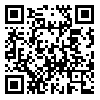2- Department of Sport Biomechanics, Faculty of Sport Sciences, Ferdowsi University of Mashhad, Mashhad, Iran.
3- Department of Physical Therapy, School of Rehabilitation Sciences, Iran University of Medical Sciences, Tehran, Iran.
4- Sport Medicine Research Center, Tehran University of Medical Science, Tehran, Iran.
Purpose: This study aimed to examine the differences in the co-activation of the rectus femoris (RF) and biceps femoris (BF) using the co-contraction index (CI) in aquatic and land environments during a drop-landing task in active and non-active females.
Methods: In this casual-comparison study, 10 active and 10 non-active females volunteered to participate. The CI was calculated from recorded surface electromyographic (SEMG) activity of the RF and BF. To calculate CI, the amount of overlap between the linear envelopes of the agonist and antagonist muscles was found and divided by the number of data points. MathLab software (version 10) was used to process row data. Also, 2-way analysis of variance (ANOVA) assessed differences between groups and environments.
Results: Results indicated that the CI was not affected by activity level in pre- and post-contact (P>0.05) while it was significantly higher (P<0.05) in land environment compared to the aquatic environment.
Conclusion: Our findings show the differences in co-contraction of knee muscles between different environments. Our measure of co-contraction was lower in water compared to land, with no difference between the active and non-active groups. This may indicate that regardless of activity level, an aquatic environment may be an appropriate choice as an early phase in rehabilitation process.
Received: 2015/03/13 | Accepted: 2015/08/27 | Published: 2015/10/1
| Rights and permissions | |
 |
This work is licensed under a Creative Commons Attribution-NonCommercial 4.0 International License. |




